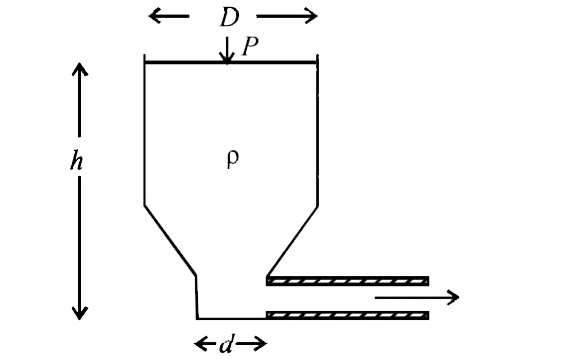A vessel fitted with a horizontal capillary tube near its bottom is alternately filled with two liquids of specific gravity 0.8 and 0.9. It empties itself in 40 and 30 minutes respectively. Calculate the ratio of their coefficient of viscosity.
The correct Answer is:1.185:1
Step by step video, text & image solution for A vessel fitted with a horizontal capillary tube near its bottom is alternately filled with two liquids of specific gravity 0.8 and 0.9. It empties itself in 40 and 30 minutes respectively. Calculate the ratio of their coefficient of viscosity. by Physics experts to help you in doubts & scoring excellent marks in Class 11 exams.
Topper's Solved these Questions
Similar Questions
Two vessels of different materials are identical in size and wall-thickness. They are filled with equal quantities of ice at 0∘C. If the ice melts completely in 10 and 25 minutes respectively, compare the coefficients of thermal conductivity of the materials of the vessels.
View SolutionFind the terminal velocity with which an air bubble of density 1kgm−3 and 0.6 mm in diameter will rise in a liquid of viscosity 0.15Nm−2s and of specific gravity 0.9 ? What is the teminal velocity of the same bubble in water of coefficient of viscosity 10−3Nm−2s?
View Solution
Knowledge Check
- Question 1 - Select One
Two liquids are allowed to flow through two capillary tubes of length in the ratio 1:2 and radii in the ratio 2:3 under the same pressure difference. If the volume rates of flow of the liquids are in the ratio 8:9 the ratio fo their coefficients of viscosity is
A1:3B3:1C4:9D9:4 - Question 2 - Select One
Two capillary tubes of same diameter are put vertically one each in two liquids whose relative densities are 0.8 and 0.6 and surface tensions are 60 dyne/cm and 50 dyne/cm respectively. Ratio of heights of liquids in the two tubes h1h2 is
A109B310C103D910 - Question 3 - Select One
A vessel contains a liquid filled with 1/10th of its volume. Another vessel contains same liquid upto 1/8th its volume. In both cases the volume in empty space remains constant at all temperatures. Then the ratio of coefficient of linear expansions of the two vessels is
A2:5B5:2C4:5D5:4
A cylindrical vessel of radius 3 cm has at the bottom a horizontal capallary tube of length 20 cm and intrnal radius 0.4 mm. If the vessel is filled with water, find the time taken by it to empty one half of its contents. Given that the viscosity of water is 0.01 poise.
View SolutionTwo syringes of different cross-sections (with out needles) filled with water are connected with a tightly fitted rubber tube filled with water. Diameters of the smaller pison and larger pistom are 1.0cm and 3.0 cm respectively.
(a) Find the force on the larger piston when a force of 10N is applied to the smaller piston.
(b) The smaller piston is pused in through 6.0 cm, much does the larger piston move out?View SolutionShown in the figure is a container whose top and botoom diameters are D and d respectively. At the bottom of the container, there is a capillary tube of outer radius b and inner radius a.
The volume flow rate in the capillary is Q. If the capillary is removed the liquid comes out with a velocity of v0. The density of the liquid is given as ρ. Calculate the coefficient of viscosity η.
 View Solution
View Solution_E01_290_Q01.png)
Shown in the figure is a container whose top and bottom diameters are D and d respectively At the bottom of the container these is a cappillary tube of outer radius b and inner radius a. the volume flow rate in the capillary is Q. if the capillary is removed the liquid comes out with a velocity of v0. The density of the liquid is given as calculate the coefficient of viscosity η (given πa2=10−6m2 and a2l=2×10−6m]View SolutionIn a horizontal capillary tube, the rate of capillary flow depends on the surface tension force as well as the viscous force. Lueas and washburn showed that the length (x) of liquid penetration in a horizontal capillary depends on a factor (k) apart from time (t). The factor is given by k=[rTcosθ2≠]1/2 , where r, T, θ and ≠ are radius of the capillary tube, surface tension, contact angle and coefficient of viscosity respectively. If the length of liquid in the capillary grows from zero to x0 in time t0,howμchtimewillbe≠ededforthe≤n>h→∈creasesomx_(0) to 4x_(0).
View Solution

